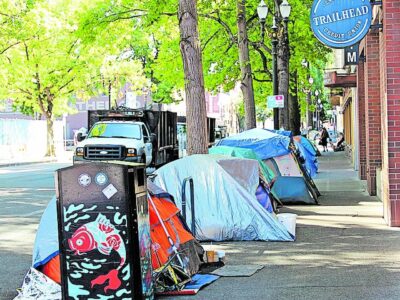- Portland, Gresham and Multnomah County has joined Built for Zero, a national initiative of more than 90 cities and counties working to measurably and equitably end homelessness
- The community will work toward addressing chronic homelessness by reaching and sustaining a milestone known as “functional zero” through the development of a by-name list of individuals.
- Functional zero is a dynamic milestone that works to ensure a sustained reality where homelessness is rare and brief.
PORTLAND, OR— Today, Community Solutions and Portland, Gresham and Multnomah County announced that they have joined Built for Zero, a national movement of more than 90 cities and counties in the United States working to measurably and equitably end homelessness.
Communities in Built for Zero work towards measurably ending homelessness for all, by strengthening data-driven systems that can continuously reduce homelessness for populations. In April 2021, Community Solutions was awarded the MacArthur Foundation’s $100 million 100&Change grant to help communities accelerate an end to homelessness through its Built for Zero initiative.
Portland, Gresham and Multnomah County will leverage this partnership to accelerate its efforts to reduce and end chronic homelessness. People who are chronically homeless are part of a federally defined population that includes individuals experiencing long-term or recurring homelessness, in shelter or unsheltered, who have a verified disability defined by The United States Department of Housing and Urban Development.
Marc Jolin, director of the Joint Office of Homeless Services, said: “This partnership will bolster ongoing community-wide efforts to measurably end homelessness, with a focus on improving access to quality data and collaboration. The Joint Office is working with Community Solutions to build a multi-disciplinary data improvement team, analyze the quality of its existing data and create a quality-improvement plan for a complete “by name” list of adults experiencing chronic homelessness.”
The local Built for Zero team will represent a community-wide effort to collaborate and develop systems to measurably end homelessness. Partner agencies and organizations include NARA, Transition Projects and the Urban League of Portland.
Portland, Gresham and Multnomah County is the sixth community in Oregon that was able to join the Built for Zero movement with support from Kaiser Permanente. Since 2019, Kaiser Permanente has been a core partner of Community Solutions, with a goal of ending chronic and veteran homelessness in communities in their shared footprint across the United States.
Tracy Dannen-Grace, Director, Community and Social Health for Kaiser Permanente Northwest, said: “We know that without a safe, stable place to live it’s nearly impossible for a person to maintain or improve their health. As a national Community Solutions partner, Kaiser Permanente is honored to support local governments and partners in their work to reduce homelessness and improve the overall health of our community.”
THE METHODOLOGY
Communities in Built for Zero are supported to fully harness quality, real-time, person-specific data to drive reductions in homelessness toward zero. Using this methodology:
- 14 communities have achieved functional zero to date, for at least one population.
- 44 communities have driven a reduction in homelessness for a population.
Shantae Smith, Systems Transformation Advisor, Community Solutions, said: “Communities in the Built for Zero initiative are demonstrating that homelessness is solvable. We are thrilled that Portland, Gresham and Multnomah County have joined the movement and are excited by the community’s commitment to building a more equitable future where homelessness is rare and brief.”
The Built for Zero methodology has been developed and refined to help communities develop coordinated, data-driven systems capable of making homelessness rare and brief for a population.
- Communities accelerate their progress using quality, real-time data. The community uses quality by-name data, which includes each person experiencing homelessness by name and provides real-time insights into their needs. This data also provides population-level insights, like inflow, outflow, and how many people are experiencing homelessness on at least a monthly basis. This will enable the community to understand the dynamics of homelessness and whether efforts are driving down the overall number of people experiencing homelessness.
- Communities work toward a shared aim of functional zero. The community-wide team will work toward achieving and sustaining functional zero, a measure for ending homelessness for a population. Communities start by reaching functional zero for an initial population, with the goal of scaling this progress to all populations. An Urban Institute report published in August 2021 found that this methodology helps communities accelerate progress across populations.
- Communities target interventions based on data. Using the by-name list, the community targets resources and investments for the maximum reductions in homelessness.
****
Built for Zero is a national initiative of more than 90 communities that have committed to measurably and equitably ending homelessness. It is led by Community Solutions, a nonprofit that works to create a lasting end to homelessness that leaves no one behind. Using a data-driven methodology, these communities have changed how local homeless response systems work and the impact they can achieve. Learn more at www.builtforzero.org or follow us at @BuiltforZero. Media Contact: Lauren Barnes, lbarnes@community.solutions, 425-728-0079


